Granite cookware offers excellent heat retention and a non-stick surface, making cooking easier. On the downside, it can be prone to chipping and may require careful handling.
Granite Cookware Pros And Cons:Granite cookware has gained popularity due to its appealing aesthetic and practical benefits. This type of cookware typically features a non-stick coating that simplifies cooking and cleanup. Unlike traditional non-stick pans, granite cookware is often more durable and resistant to scratches.
Many home chefs appreciate its ability to retain heat, resulting in even cooking. However, potential downsides exist, such as susceptibility to chips and cracks with rough use. Knowing the pros and cons helps consumers make informed choices when selecting the right cookware for their kitchen needs. Understanding these factors ensures an enjoyable cooking experience without unexpected issues.
Introduction To Granite Cookware
Granite cookware is a popular choice for many kitchens. It offers both style and functionality. This cookware is durable and easy to clean. Many people love it for its non-stick properties.</p
Origins And Composition
Granite cookware is not made from granite. It typically consists of a metal base coated with a layer of enamel. This enamel gives it a smooth surface. The composition often includes:
- Aluminum or steel base
- Non-stick enamel coating
- Colorful designs
The process of creating granite cookware dates back to the mid-20th century. It gained popularity for its attractive appearance. It combines aesthetic appeal with practical cooking benefits.
Popularity And Trends
Granite cookware has become trendy in modern kitchens. Home cooks appreciate its stylish look. It fits well with various kitchen designs.
Key reasons for its popularity include:
- Non-stick surface for easy cooking
- Durable and long-lasting
- Variety of colors and styles available
Social media platforms showcase beautiful granite cookware sets. Many cooking influencers recommend it. This has increased its visibility and demand.
“`
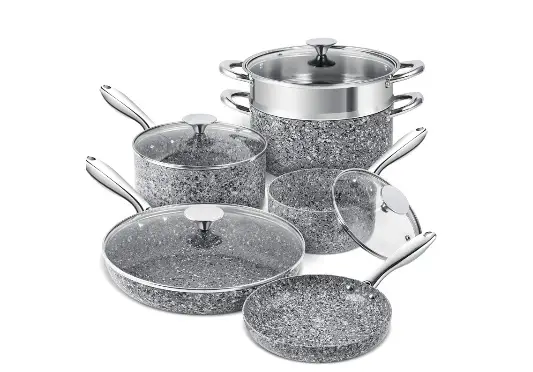
Credit: thekitchenpursuits.com
Advantages Of Using Granite Cookware
Granite cookware offers many benefits. It provides durability, excellent cooking performance, and a stylish look. Here are some key advantages of using granite cookware.
Durability And Longevity
Granite cookware is highly durable. It can withstand high temperatures without warping or scratching. This makes it ideal for daily use. Users can enjoy a long lifespan with proper care.
- Resistant to chipping
- Can last for years
- Less prone to damage compared to other materials
Granite cookware is also resistant to rust. This quality adds to its longevity. It remains visually appealing even after extensive use.
Non-stick Qualities
Granite cookware features excellent non-stick properties. Food releases easily, which makes cooking and cleaning simple. Less oil or butter is needed for cooking. This helps in preparing healthier meals.
- Easy food release
- Reduces sticking
- Makes cleaning a breeze
Granite’s non-stick surface is safe. It does not release harmful chemicals. This ensures a safe cooking environment for your family.
| Feature | Granite Cookware | Other Cookware |
|---|---|---|
| Durability | High | Varies |
| Non-Stick | Yes | Depends on coating |
| Health Safety | Yes | Varies |
Overall, granite cookware is a smart choice. It combines durability with non-stick benefits. Enjoy cooking with style and ease.
Health And Safety Considerations
Granite cookware offers durability and beauty. However, health and safety are key factors to consider. Understanding toxicity and heat distribution is essential for safe cooking.
Toxicity Concerns
Granite cookware is generally safe. It is often free from harmful chemicals. Here are some important points:
- No PFOA or PTFE: These chemicals are not present in granite cookware.
- Non-reactive Surface: Granite does not react with food.
- Safe for High Heat: Can withstand high temperatures without leaching.
Always check for certifications. Look for products that meet safety standards. This ensures you use safe cookware.
Heat Distribution And Retention
Granite cookware provides excellent heat distribution. This leads to even cooking. Here are some benefits:
| Feature | Benefit |
|---|---|
| Even Heating | Prevents hotspots and burns food. |
| Heat Retention | Food stays warm longer after cooking. |
| Energy Efficient | Reduces cooking time and energy use. |
Use granite cookware at medium heat. This helps maintain the cookware’s integrity. Avoid sudden temperature changes. This prevents cracks or damage.

Credit: www.pinterest.com
Aesthetic Appeal
Granite cookware offers a unique blend of style and function. Its elegant look enhances any kitchen. Home chefs enjoy not only cooking but also showcasing their cookware.
Variety Of Designs
Granite cookware comes in many designs. This variety allows for personal expression in the kitchen. Here are some popular styles:
- Solid Colors: Bright and bold choices.
- Marble Patterns: Elegant and timeless.
- Textured Finishes: Adds depth to the design.
Each design can match different themes. Whether modern or rustic, granite cookware fits right in.
Impact On Kitchen Decor
Granite cookware can transform a kitchen’s look. It creates a cohesive aesthetic. Here’s how it impacts decor:
| Aspect | Effect |
|---|---|
| Color Harmony | Complements existing color schemes. |
| Visual Interest | Creates focal points on countertops. |
| Texture | Enhances tactile experience. |
Granite cookware can also inspire kitchen organization. Displaying it neatly adds charm. Its presence can make cooking feel more enjoyable.
Maintenance And Care
Proper maintenance and care are essential for extending the life of your granite cookware. Regular cleaning and avoiding damage will keep your pots and pans looking new. Follow these guidelines to ensure your cookware remains in great condition.
Cleaning Best Practices
Cleaning your granite cookware correctly is crucial. Here are some effective cleaning methods:
- Let cookware cool before washing.
- Use warm, soapy water and a soft sponge.
- Avoid abrasive cleaners or scouring pads.
- Rinse thoroughly and dry with a soft cloth.
For tough stains, try this:
- Mix baking soda and water to form a paste.
- Apply the paste to the stain and let it sit.
- Gently scrub with a soft sponge.
- Rinse and dry as usual.
Avoiding Common Damages
Preventing damage is just as important as cleaning. Follow these tips to avoid common issues:
| Common Issue | Prevention Tips |
|---|---|
| Scratches | Use wooden or silicone utensils only. |
| Chips | Store cookware carefully, avoiding heavy stacking. |
| Discoloration | Avoid cooking acidic foods for long periods. |
| Warping | Don’t heat empty cookware on high heat. |
By following these maintenance tips, your granite cookware will remain a cherished part of your kitchen for years. Enjoy cooking with confidence!
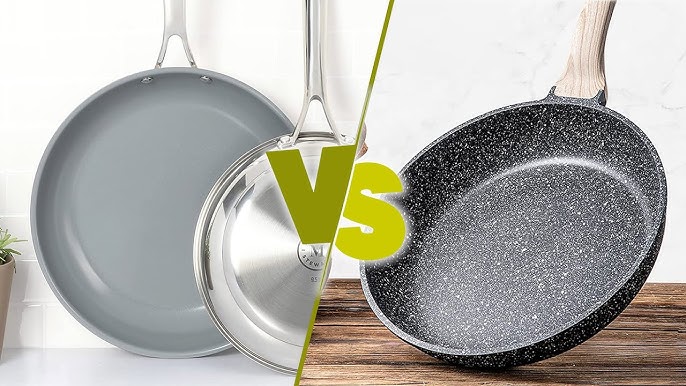
Credit: m.youtube.com
Cost-effectiveness
Granite cookware offers a unique blend of durability and performance. Understanding its cost-effectiveness helps in making an informed choice. Here’s a closer look at the financial aspects.
Initial Investment
The initial cost of granite cookware varies widely. Prices depend on brand, size, and features. Generally, granite cookware is more affordable than high-end options like copper or stainless steel.
- Average price range: $30 to $150
- Durable lifespan: 5 to 10 years
- Requires less maintenance than some materials
Investing in granite cookware can save money over time. It resists scratches and chips, leading to fewer replacements.
Comparison With Other Cookware Materials
| Cookware Material | Initial Cost | Lifespan | Maintenance |
|---|---|---|---|
| Granite | Moderate | 5-10 years | Low |
| Stainless Steel | Higher | 10-20 years | Medium |
| Non-stick | Lower | 3-5 years | High |
| Copper | Highest | 10-15 years | High |
Granite cookware stands out for its balance of price and longevity. It offers better value than non-stick options, which wear out quickly.
Granite cookware is a wise choice for budget-conscious cooks. Its durability and low maintenance add to its overall value.
Environmental Impact
Granite cookware offers many benefits, but it also has an impact on the environment. Understanding these effects helps consumers make informed choices. Two key areas to explore are sustainability and recyclability.
Sustainability Factors
Granite cookware is often made from natural materials. This can lead to a lower carbon footprint compared to other cookware types. Here are some sustainability aspects to consider:
- Natural Resources: Granite comes from the earth. It is a renewable resource.
- Durability: Granite cookware lasts a long time. This reduces waste.
- Production Processes: Many brands use eco-friendly manufacturing methods.
Recyclability And Disposal
Disposing of cookware responsibly is essential. Granite cookware can be challenging to recycle. Here are some important points:
| Material | Recyclability | Disposal Options |
|---|---|---|
| Granite | Limited | Landfill, repurpose |
| Non-stick coating | Varies by brand | Landfill, check local guidelines |
Always check local recycling guidelines. Some areas have special programs for cookware disposal.
Consumer Reviews And Feedback
Granite cookware has gained popularity among home cooks. Many consumers share their experiences online. Their feedback reveals the true nature of this cookware.
Positive Experiences
Many users praise granite cookware for its performance. Here are some common positive points:
- Non-stick surface: Food easily slides off.
- Even heating: Cooks food uniformly.
- Stylish design: Enhances kitchen aesthetics.
- Durable: Long-lasting with proper care.
Consumers love the variety of colors. They enjoy cooking with safe materials. Many report less oil usage, making meals healthier.
Reported Issues And Drawbacks
Not all feedback is positive. Some users face challenges with granite cookware. Here are common concerns:
- Chipping: Some pots chip easily over time.
- Weight: Heavier than traditional cookware.
- Price: Can be more expensive than alternatives.
- Care requirements: Needs careful cleaning and handling.
Users warn against using metal utensils. This can scratch the surface. Regular maintenance is crucial for longevity.
Making An Informed Decision
Choosing the right cookware is essential for successful cooking. Granite cookware offers unique features that appeal to many cooks. Understanding its pros and cons helps you make a smart choice.
Matching Cookware To Cooking Needs
Selecting cookware depends on your cooking style. Granite cookware can be a great option for various tasks. Here are some benefits:
- Durability: Granite cookware lasts longer than many other materials.
- Non-stick surface: It makes cooking and cleaning easier.
- Even heating: Food cooks uniformly, reducing hot spots.
Consider the drawbacks too:
- Weight: Granite cookware can be heavier than alternatives.
- Cost: It may be pricier than standard cookware.
- Care: Requires special cleaning to maintain its surface.
Evaluate your cooking needs. If you cook frequently and enjoy healthy meals, granite cookware is a good fit.
Final Thoughts On Granite Cookware
Granite cookware offers a blend of beauty and functionality. Its unique look enhances your kitchen. It is available in various colors and designs.
Before purchasing, check your cooking habits. Consider how often you cook and what types of meals you prepare.
| Feature | Granite Cookware | Other Cookware Types |
|---|---|---|
| Durability | High | Medium |
| Non-stick | Yes | Varies |
| Weight | Heavy | Light to Medium |
| Price | Higher | Lower |
Granite cookware can elevate your cooking experience. Make a choice that aligns with your culinary needs.
Granite Cookware: A Comprehensive Guide to Pros and Cons
In the realm of kitchenware, granite cookware stands out as a modern and stylish choice for those seeking an alternative to conventional non-stick surfaces. Despite its name, granite cookware does not contain actual granite. Instead, it consists of a metal core—usually aluminum—coated with a porcelain enamel that not only provides a smooth, non-stick surface but also imparts a distinctive, speckled appearance that resembles granite stone. This guide dives into the benefits and drawbacks of granite cookware to help you assess whether it aligns with your culinary needs and preferences.
Key Features of Granite Cookware
Understanding what differentiates granite cookware from other cookware types is essential:
- Composition: Granite cookware typically has an aluminum core known for its excellent heat conductivity, which is then coated with a robust porcelain enamel.
- Appearance: It is prized for its aesthetic qualities, often featuring a gray or black color with a speckled pattern that mimics the look of natural granite.
- Performance: Known for its natural non-stick properties, granite cookware achieves this without the need for chemical coatings such as PTFE (Teflon).
Advantages of Granite Cookware
Granite cookware’s popularity is not without merit; it offers several advantages that make it a worthwhile addition to any kitchen:
- Non-Stick Surface: Its cooking surface is excellent for reducing food sticking, thereby cutting down on the need for excessive oil or butter.
- Even Heat Distribution: Thanks to the aluminum core, granite cookware heats quickly and evenly, helping to prevent hot spots and ensure uniformly cooked meals.
- Durability: The porcelain enamel coating is notably tough, offering resistance to chips and scratches under typical kitchen usage.
- Ease of Cleaning: Its smooth surface is straightforward to clean, compatible with both hand washing and dishwashers.
- Aesthetic Appeal: Granite cookware adds a touch of style to any kitchen with its unique and attractive design.
Table: Pros of Granite Cookware
| Advantage | Description |
|---|---|
| Non-Stick | Reduces food sticking for easier cooking and cleanup |
| Even Heating | Ensures food cooks evenly by preventing hot spots |
| Durability | Withstands chips and scratches, enhancing longevity |
| Easy to Clean | Simplifies maintenance with dishwasher compatibility |
| Attractive Design | Offers a stylish appearance with a unique pattern |
Disadvantages of Granite Cookware
Despite its numerous benefits, granite cookware comes with certain limitations that might affect your buying decision:
- Weight: Granite cookware is generally heavier than other non-stick cookware, which may be challenging for those with limited hand strength.
- Heat Limitations: It is not suitable for very high-temperature cooking, such as searing meats, as it cannot withstand temperatures as high as all-metal cookware can.
- Initial Cost: Typically, granite cookware is more expensive than basic non-stick options, though it is usually less costly than high-end brands.
- Induction Compatibility: Most granite cookware is not compatible with induction cooktops unless it has a specially designed base.
- Chemical Concerns: While early versions of granite cookware contained PFOA in the enamel coating, most modern versions are PFOA-free, mitigating this concern.
Table: Cons of Granite Cookware
| Disadvantage | Description |
|---|---|
| Weight | Heavier build may make handling difficult |
| Temperature Sensitivity | Unsuitable for high-temperature cooking techniques |
| Cost | More expensive than some other non-stick cookware options |
| Compatibility | Often incompatible with induction stovetops |
| Chemicals | Older models may contain harmful chemicals |
Granite cookware, with its non-stick properties, durability, and unique aesthetic, presents a viable option for those seeking to combine style and functionality in their kitchen tools. However, considerations such as its weight, cost, and certain cooking limitations should be factored into your decision. As with any type of cookware, understanding the strengths and weaknesses of granite cookware will enable you to maximize its benefits and thoroughly enjoy your cooking experiences. Whether granite cookware meets your needs will depend on your specific cooking practices, preferences, and budget.
Granite cookware vs Stainless steel
When selecting between granite and stainless steel cookware, it’s essential to weigh various factors such as your cooking style, maintenance habits, durability needs, and health considerations. Each type of cookware has unique advantages and disadvantages, offering distinct benefits depending on your kitchen requirements. Below is an in-depth comparison to assist in making a well-informed decision:
Granite Cookware
Pros:
- Non-Stick Surface: Granite cookware is actually a metal base, typically aluminum, coated with a porcelain enamel that provides a naturally non-stick surface. This feature allows for cooking with less oil and simplifies cleaning.
- Even Heat Distribution: The aluminum core of granite cookware ensures quick and even heating, eliminating hot spots and facilitating uniform cooking.
- Aesthetic Appeal: Known for its speckled appearance, granite cookware often looks more stylish than plain stainless steel, enhancing the aesthetic of your kitchen.
- Acid Resistance: The porcelain enamel coating is non-reactive, making it safe for cooking acidic foods without the risk of leaching.
Cons:
- Durability Issues: Although tough, the porcelain enamel can chip or crack if mishandled, potentially reducing the cookware’s lifespan.
- Temperature Sensitivity: Granite cookware is not suitable for very high temperatures, limiting its use in high-heat cooking methods such as searing.
- Heavier Weight: Generally, granite cookware is heavier than stainless steel, which may be cumbersome for some users.
Stainless Steel Cookware
Pros:
- Robust Durability: Stainless steel is exceptionally durable, resistant to rust, corrosion, and staining, ensuring longevity.
- High Heat Capacity: Capable of withstanding very high temperatures, stainless steel is ideal for searing, browning, and other high-heat cooking techniques.
- Versatility: Suitable for all cooking surfaces, including induction, and often safe for oven use, stainless steel offers extensive culinary flexibility.
- Non-Reactive: It does not react with acidic or alkaline foods, preserving the food’s flavor and preventing chemical leaching.
Cons:
- Inconsistent Heat Distribution: Stainless steel alone does not distribute heat well, which can lead to uneven cooking. However, many stainless steel cookware items include an aluminum or copper core to mitigate this issue.
- Maintenance Challenges: Lacking non-stick properties, stainless steel can be difficult to clean if food burns onto the surface and generally requires more oil to prevent sticking.
- Aesthetic Maintenance: Stainless steel can show water spots and fingerprints, necessitating regular polishing to maintain its appearance.
Which is Better for You?
Cooking Style: If you prefer cooking at low to medium heat and value easy cleanup, granite cookware with its non-stick convenience might be more suitable. Conversely, if you often use high-heat techniques and don’t mind the extra cleaning effort, stainless steel would be the better choice.
Health Considerations: Both cookware types are generally safe, but if you are cautious about chemical non-stick coatings, granite cookware’s porcelain-based layer offers a PFOA- and PFAS-free alternative. Stainless steel naturally contains no such chemicals.
Durability and Longevity: Stainless steel typically offers greater durability, particularly in demanding cooking environments where cookware must endure frequent use.
Ultimately, your choice between granite and stainless steel cookware will depend on your specific culinary needs, aesthetic preferences, and willingness to maintain the cookware. Each material presents unique benefits, so consider what attributes are most crucial for your cooking activities.
Ninja Cookware vs. Granite Stone: Which Suits Your Kitchen Best?
Selecting the right cookware involves careful consideration of material qualities and brand reputations. This detailed comparison between Ninja Cookware and Granite Stone highlights the unique attributes each brand offers, assisting you in finding the cookware that best aligns with your kitchen needs.
Introduction to Ninja Cookware
Ninja Cookware, part of the innovative Ninja kitchen appliance lineup, is designed for both durability and versatility, emphasizing non-stick performance and ease of use.
Advantages of Ninja Cookware:
- Non-stick Performance: Features a high-quality, PTFE-free non-stick coating, promoting healthier cooking with reduced oil use.
- Even Heat Distribution: Specifically engineered to distribute heat evenly, ensuring meals cook uniformly without any hot spots.
- Oven-Safe: Withstands higher oven temperatures, making it suitable for a variety of cooking methods.
- Ease of Cleaning: Dishwasher safe, this cookware simplifies maintenance and clean-up.
Drawbacks of Ninja Cookware:
- Cost: Generally comes at a higher price point, reflecting its premium construction and features.
- Weight: The cookware’s robust build makes it heavier, which could be a concern for some users in terms of handling and storage.
Overview of Granite Stone Cookware
Granite Stone Cookware is celebrated for its exceptional durability and impressive non-stick properties, thanks to its triple-layer, diamond-infused granite stone finish. It is often preferred for its performance and cost-effectiveness.
Advantages of Granite Stone Cookware:
- High Durability: The diamond-infused triple-layer non-stick coating greatly enhances wear resistance.
- Cost-Effectiveness: Offers a more affordable option compared to many non-stick cookware brands, without sacrificing quality.
- Visual Appeal: Features a distinctive stone-like finish that adds aesthetic value to any kitchen decor.
- Lightweight: Easier to handle due to its relatively lighter weight compared to other non-stick cookware.
Drawbacks of Granite Stone Cookware:
- Heat Limitations: Not ideal for very high-temperature cooking, which can restrict its use in certain culinary applications.
- Induction Compatibility: Not all models are compatible with induction cooktops, which may limit their versatility depending on your cooking setup.
Comparative Analysis: Ninja Cookware vs. Granite Stone
To provide a clear comparison, here’s a breakdown of key features for both cookware lines:
| Feature | Ninja Cookware | Granite Stone |
|---|---|---|
| Non-stick Quality | High-quality PTFE-free coating | Triple-layer, diamond-infused coating |
| Price | Higher price point | More affordable |
| Durability | Durable with proper care | Extremely durable with diamond coating |
| Oven Safety | High temperature tolerance | Moderate temperature tolerance |
| Weight | Heavier build | Lighter, easy to handle |
| Dishwasher Safe | Yes | Yes, but hand washing recommended |
| Aesthetic | Modern and sleek | Natural granite look |
| Induction Ready | Yes, depending on the model | Not all models are induction compatible |
Deciding between Ninja Cookware and Granite Stone depends largely on your specific needs and preferences. If you prioritize advanced non-stick features, are willing to invest more, and need cookware that handles high temperatures well, Ninja might be the ideal choice. Conversely, if you seek affordability, high durability, and prefer a lighter cookware with a unique aesthetic, Granite Stone could better meet your expectations. Both lines offer significant benefits, so your decision will hinge on which features align best with your cooking habits and kitchen style.
Comprehensive Review: Project Farm Nonstick Pans
Project Farm is renowned for its meticulous testing and analysis of consumer products, including nonstick pans. This review explores the performance, durability, and overall value of nonstick pans as tested by Project Farm, providing insight into which pans might best meet your cooking needs. We will examine their resilience under typical kitchen stress, user-friendliness, and cost-effectiveness.
Key Attributes of Nonstick Pans as Tested by Project Farm
- Durability: Focuses on how well the pans can withstand high heat, utensil scratches, and regular wear and tear.
- Nonstick Performance: Assesses how effectively the nonstick surface holds up over time and under various cooking conditions.
- Heat Distribution: Evaluates the ability of the pans to evenly distribute heat, which is crucial for uniform cooking results.
- Ease of Cleaning: Investigates the ease with which these pans can be cleaned after preparing sticky or burnt dishes.
- Value for Money: Considers whether the cost is justified by the pan’s performance and durability.
Advantages of Top-Rated Nonstick Pans from Project Farm
- Effective Nonstick Surface: Superior pans maintain their nonstick properties even after prolonged use, reducing the need for oils or butters.
- Sturdy Construction: These pans are highly rated for their build quality, showing resistance to warping and other common damages.
- Uniform Heat Distribution: Top performers are noted for their exceptional ability to cook food evenly, avoiding hot spots.
- Simple Maintenance: The best pans are easy to clean, requiring little effort beyond basic washing.
- Affordable Options: Many of the highest-performing pans are also budget-friendly, offering excellent value.
Drawbacks of Lower-Rated Nonstick Pans from Project Farm
- Poor Durability: Some pans deteriorate quickly, particularly in their nonstick coating or overall structural integrity.
- Inconsistent Cooking: Lesser-rated pans often struggle with heat distribution, leading to uneven cooking and subpar meal quality.
- Challenging Cleanup: Despite claiming nonstick capabilities, some pans have issues with food residue, making them difficult to clean.
- Cost vs. Performance: Higher-priced pans do not always guarantee superior performance or longer durability.
Comparative Analysis: Project Farm’s Nonstick Pans
| Feature | Top-Rated Pans | Lower-Rated Pans |
|---|---|---|
| Nonstick Quality | Excellent, durable | Quickly degrades, less effective |
| Durability | Resistant to scratches and heat | Susceptible to scratches, warping |
| Heat Distribution | Even and consistent | Uneven, prone to hot spots |
| Ease of Cleaning | Very easy, minimal effort needed | Difficult, often requires soaking |
| Price | Affordable, great value | Expensive relative to performance |
Project Farm’s rigorous testing highlights significant variances in the quality and functionality of nonstick pans. When choosing a nonstick pan, consider its performance in key areas such as durability, cooking efficiency, ease of maintenance, and value for money. The ideal nonstick pan should offer a blend of superb cooking performance, long-lasting durability, effortless cleaning, and economic value. Selecting a pan based on thorough testing and reviews ensures that you invest in cookware that fulfills your culinary needs and fits your budget.
Frequently Asked Questions
What Are The Benefits Of Granite Cookware?
Granite cookware offers excellent heat distribution, ensuring even cooking. It is non-reactive, making it safe for acidic foods. Additionally, granite is durable and scratch-resistant, which helps maintain its appearance over time. This type of cookware is also easy to clean, enhancing its appeal for everyday use.
Is Granite Cookware Safe For Health?
Yes, granite cookware is generally safe for health. It is often coated with a non-toxic layer, ensuring that no harmful chemicals leach into food. However, always check for quality certifications to ensure safety standards. Proper use and care can maintain its safety and longevity.
How Do You Maintain Granite Cookware?
To maintain granite cookware, avoid using metal utensils that can scratch the surface. Clean it gently with a soft sponge and mild detergent. Avoid soaking for long periods, as this can damage the coating. Store it carefully to prevent chips and scratches for lasting performance.
Can Granite Cookware Go In The Oven?
Yes, many granite cookware pieces are oven-safe. However, it’s essential to check the manufacturer’s guidelines for specific temperature limits. Generally, granite cookware can withstand moderate oven temperatures. Always ensure the handles are also oven-safe to prevent accidents while cooking.
Conclusion
Granite cookware offers durability and a stylish appearance, making it an attractive choice for many kitchens. Its non-stick properties enhance cooking and cleaning convenience. Yet, it’s essential to consider potential drawbacks, such as weight and care requirements. Weighing these pros and cons will help you make an informed decision for your cooking needs.
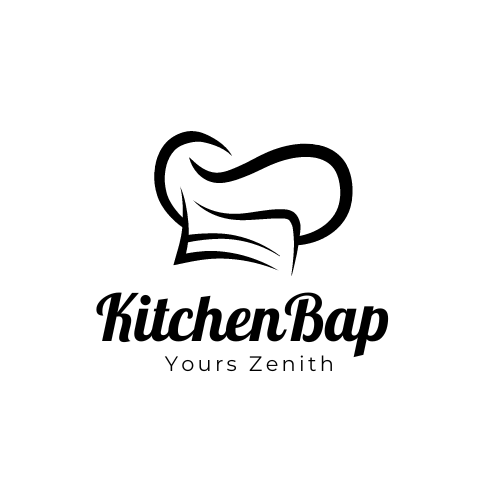


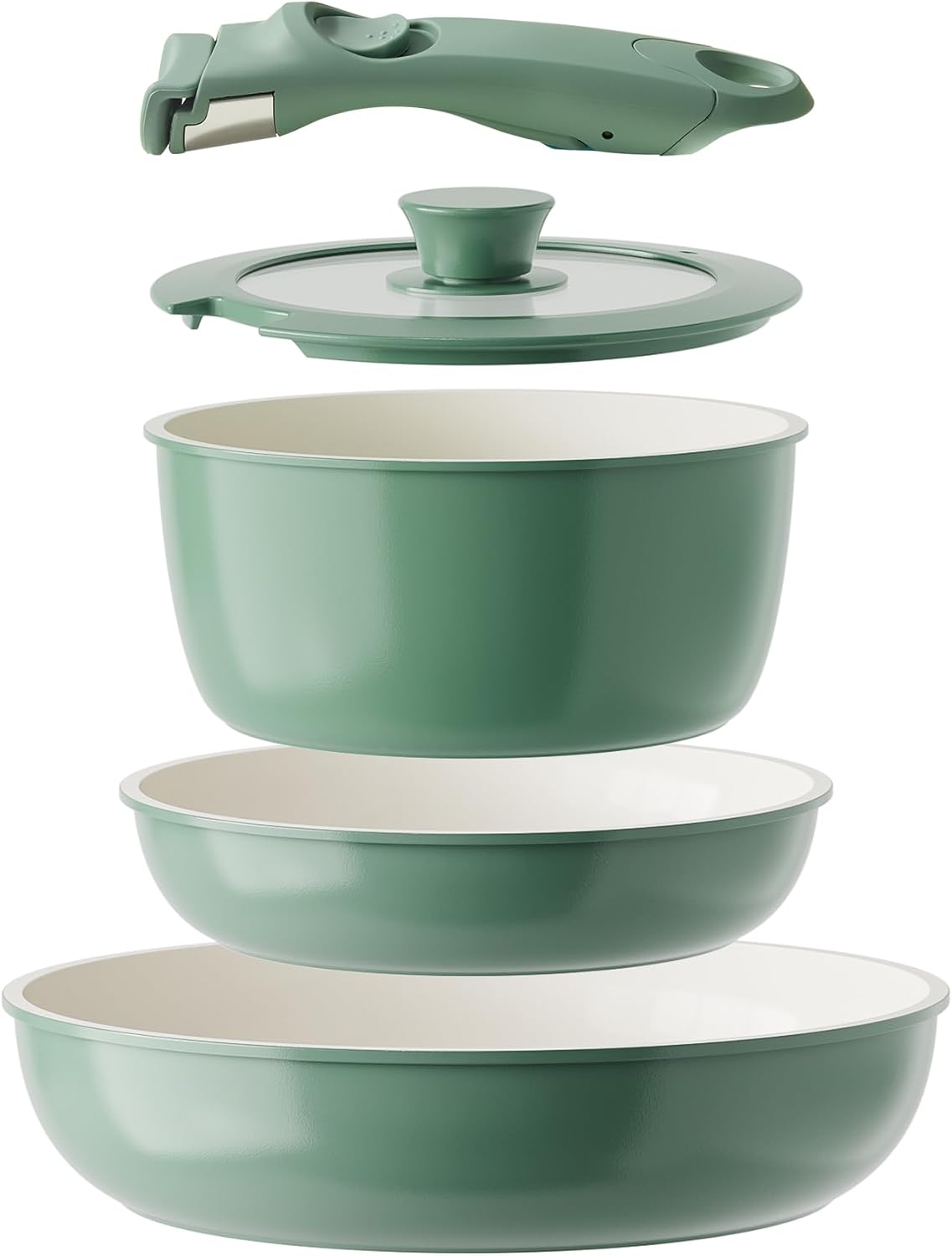
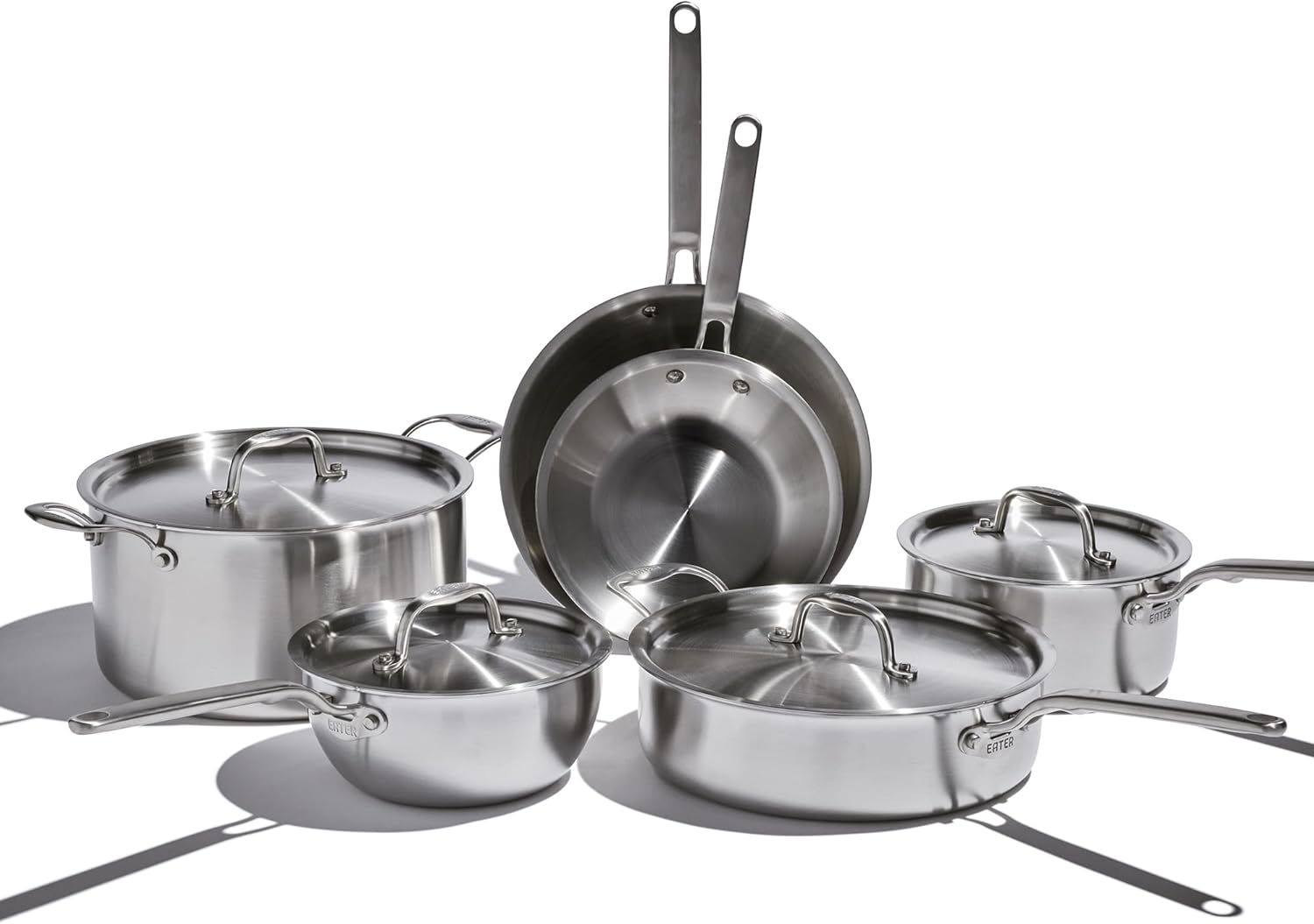
Leave a Reply